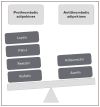Mechanisms of thrombosis in obesity
- PMID: 23817170
- PMCID: PMC4445633
- DOI: 10.1097/MOH.0b013e3283634443
Mechanisms of thrombosis in obesity
Abstract
Purpose of review: Obesity has become a worldwide epidemic that is driving increased morbidity and mortality from thrombotic disorders such as myocardial infarction, stroke, and venous thromboembolism. Effective prevention and treatment of thrombosis in obese patients is limited by an incomplete understanding of the underlying prothrombotic mechanisms and by uncertainties about risks, benefits, and dosing of anticoagulant drugs in this patient population.
Recent findings: This review summarizes our current understanding of established and emerging mechanisms contributing to the obesity-induced prothrombotic state. The mechanistic impact of chronic inflammation and impaired fibrinolysis in mediating obesity-associated thrombosis is highlighted. Recent data demonstrating the aberrant expression of adipokines and microRNAs, which appear to function as key modulators of proinflammatory and prothrombotic pathways in obesity, are also reviewed. Finally, some challenges and new approaches to the prevention and management of thrombotic disorders in obese and overweight patients are discussed.
Summary: Obesity-driven chronic inflammation and impaired fibrinolysis appear to be major effector mechanisms of thrombosis in obesity. The proinflammatory and hypofibrinolytic effects of obesity may be exacerbated by dysregulated expression and secretion of adipokines and microRNAs, which further increase the risk of thrombosis and suggest new potential targets for therapy.
Conflict of interest statement
There are no conflicts of interest
Figures


References
-
- Go AS, Mozaffarian D, Roger VL, et al. Heart disease and stroke statistics: ▪ 2013 update – a report from the American Heart Association. Circulation. 2013;127:e6–e245. This study summarizes the latest epidemiological data from the American Heart Association, illustrating the size and scope of the obesity epidemic. - PMC - PubMed
-
- World Health Organization Fact Sheet N311. Obesity and overweight. 2013
-
- Wolk R, Berger P, Lennon RJ, et al. Body mass index: a risk factor for unstable angina and myocardial infarction in patients with angiographically confirmed coronary artery disease. Circulation. 2003;108:2206–2211. - PubMed
-
- Yusuf S, Hawken S, Ounpuu S, et al. Obesity and the risk of myocardial infarction in 27 000 participants from 52 countries: a case-control study. Lancet. 2005;366:1640–1649. - PubMed
-
- Rexrode KM, Hennekens CH, Willett WC, et al. A prospective study of body mass index, weight change, and risk of stroke in women. JAMA. 1997;277:1539–1545. - PubMed
Publication types
MeSH terms
Substances
Grants and funding
LinkOut - more resources
Full Text Sources
Other Literature Sources
Medical
Research Materials

